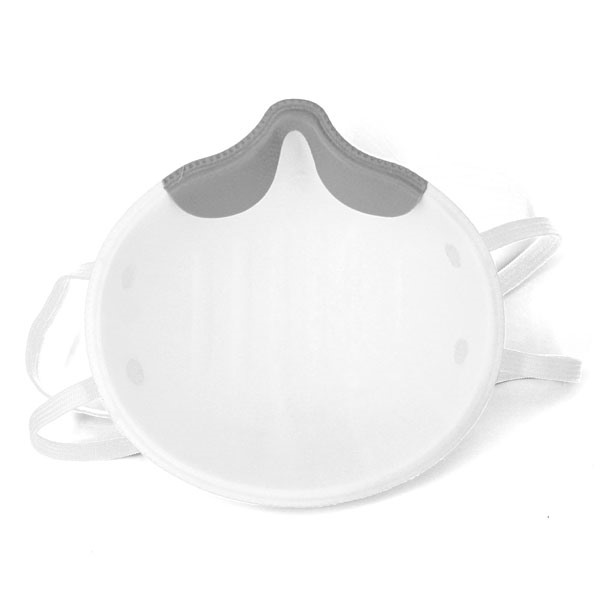Wearing a medical protective mask is one of the most important measures to prevent respiratory infections. The U.S. National Institute of Occupational Safety and Health (NIOSH) and the World Health Organization recommend N95 medical protective masks (“N95 masks”) for the prevention and treatment of respiratory infections, but there are no recommendations on when to wear them. At present, most hospitals, even those with respiratory infections, still mainly wear general medical masks and surgical masks, and a few hospitals that wear N95 masks are more likely to wear them based on their own experience. By comparing the protective efficiency of different masks, and at the same time testing the protection efficiency and breathing resistance of wearing N95 masks at different times, the author evaluates the wear time and protection efficiency of N95 masks, so as to provide reference for personal protection of respiratory infectious diseases.
 The filtering effect of different masks compared the filtration efficiency and breathing resistance of several types of masks tested before use, of which the filtration efficiency of N95 masks was the highest, with an average of 97.4%, but its breathing resistance was also the largest, reaching 13. 8mmH2O; surgical masks are the least efficient to filter, at 18. 4%, but its breathing resistance was the lowest, at 1.8mm H2O. The 24-layer gauze mask has a filtration efficiency of 43.9%, slightly higher than the 12th floor, but its breathing resistance almost doubled (6.6:3.9). Shining Star N95 masks brand is doing a good job in this regard.
The filtering effect of different masks compared the filtration efficiency and breathing resistance of several types of masks tested before use, of which the filtration efficiency of N95 masks was the highest, with an average of 97.4%, but its breathing resistance was also the largest, reaching 13. 8mmH2O; surgical masks are the least efficient to filter, at 18. 4%, but its breathing resistance was the lowest, at 1.8mm H2O. The 24-layer gauze mask has a filtration efficiency of 43.9%, slightly higher than the 12th floor, but its breathing resistance almost doubled (6.6:3.9). Shining Star N95 masks brand is doing a good job in this regard.
N95 mask better than surgical mask
Wearing different time filtration effect compared to flat and surgical mask before use of the filtration efficiency is much lower than N95 mask, so it was not tested in the use of filtration efficiency changes, only analysis of N95 mask use during the filtration efficiency and respiratory resistance changes.
 The filtration efficiency of the N95 mask is gradually reduced with the time of use, and the average filtration efficiency on the third day is 94. 7%, compared with 95% of the standard, the difference is statistically significant (t-6. 26,P=0. 000), but still higher than the European standard EN149:2001 FFP2 and FFP3;
The filtration efficiency of the N95 mask is gradually reduced with the time of use, and the average filtration efficiency on the third day is 94. 7%, compared with 95% of the standard, the difference is statistically significant (t-6. 26,P=0. 000), but still higher than the European standard EN149:2001 FFP2 and FFP3;
- After 5 working days, the filtration efficiency is reduced to 92. 0%;
- After 14 working days, the filtration efficiency is still more than 80% (80. 6%).
The breathing resistance of the N95 mask changed little throughout the process, at 11. 4~13. Between 6mmH2O, are well below the national standard of 35mm H2O, the highest resistance value and national standard compared to the difference is statistically significant (t.176.3,P=0.000). BESTG N95 masks is pretty good.
The protection efficiency and wearing time of the mask are the most important concerns of the user. A safe and effective mask should be optimal in terms of protection efficiency, wear time and cost-effectiveness. Gauze masks, surgical masks and N95 masks are the most commonly used measures in respiratory protection in medical institutions, so it is of great practical significance to study them for infection control in medical institutions. For 0. Particles of 075 m, N95 mask filtration efficiency is the best, can reach more than 97%, for most pathogens (e.g. Mycobacteria tuberculosis, its carrier of transmission moth core diameter of 1 to 4 m, is 13 to 53 times the diameter of the test particles) can achieve safety protection. Gauze mask filtration efficiency is only 30% to 40%, which means that more than 1/2 of the particles will be able to pass through the gauze mask, so its filtration effect is low. The most worrying concern is surgical masks, which are less than 20 per cent more efficient to filter, making it difficult to use surgical masks to prevent inhalation respiratory diseases. RESPOKARE N95 masks brand is doing a good job in this regard.
In fact, surgical masks are not designed to reduce the wearer’s inhalation of pathogens, but to reduce the wearer’s diffission of droplet cores to the outside world.
Therefore, the purpose of the use of various masks should be clear, surgical masks and gauze masks are used to protect others, and medical protective masks are used to protect the wearer himself.
N95 masks can be worn for 3 days without contamination
At present, including the WHO on the N95 mask the best time to wear has not been clearly concluded, the N95 mask after use of the preservation conditions put forward requirements (indicating that it can be made again, but there is no regulation of the mask use time. Some medical institutions recommend replacing one for every 4 hours, some literature studies recommend 2 days, while others wear it for months, and some make it clear that N95 masks can be reused. The study found that N95 mask wearing 2 days, filtration efficiency remained above 95%, breathing resistance changes little; 7%, still meeting euro standard EN149:2001-FFP2 requirements; Under the test conditions, the volunteers wore it continuously within 4h, simulating the environment in which medical personnel needed to use it continuously in an emergency. In practice, most of them are worn only in contact with the patient, and the intensity of use is much lower than the experimental conditions. Therefore, it is theoretically possible to wear 3 days on an N95 mask.
The above mask usage time is the test results under normal conditions of use, medical protective masks should be replaced immediately in the case of contamination, moisture and damage, and should be shortened in high-risk environments. GIKO N95 masks performed well.
The cost-effectiveness of wearing a mask is also an important factor in the time it takes to wear it. The N95 medical protective mask is currently on the N95 Wholesale market for about USD $1.50 – $5.00 per mask. In terms of cost-effectiveness and safety, two can be used five working days a week during the outbreak (if not contaminated, wet and damaged); In short, N95 mask filtration efficiency is much higher than gauze mask and surgical mask, and can be used for a long time, can be widely used in respiratory-borne disease infection control.




Cool! The science of decontaminating a n95 mask sounds very interesting